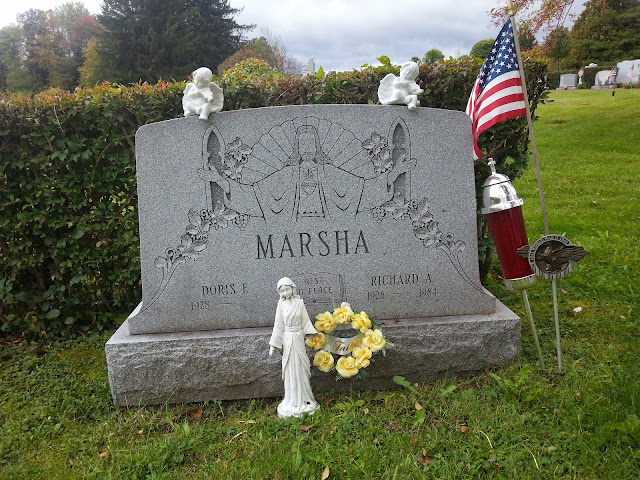What better place than the "Granite Capital of the World" to see some of the most interesting and inspiring stone sculpture immortalizing those at rest, than at the Hope Cemetery, in Barre, Vermont?
I took a stroll through Hope last Sunday afternoon, and was awe-struck with not only the incredible artistry, but was touched by the symbolism and profound expression of love, loss and immortality.
I hope you enjoy my photography, and I will not add any further comment other than my thought that perhaps the cemetery should be renamed "Hope, Faith and Love". At the end of the photographs posted below is a brief history of Hope, provided by examiner.com. I will now let the graves speak for themselves. Peace.
 |
| This young lady was a victim of a lightening strike. Previous to this monument was a plain stone. Friends and family donated a community headstone, in all of it's grandeur, in loving memory of Amy. |
 |
| Note "face of death" sculptured into right lower side of memorial. |
 |
| A |
 |
| See below for more on the Brussa Angel |
Barre (pronounced Barry) Vermont is the source of granite for much of the country. Its fine quality stone and artisans who turned granite into sculpture are known nation-wide. But nowhere is their skill better showcased than in the place where their loved ones rest.
Barre granite became famous for its unique ability to resist discoloration - neither time or weather changes the color of the stone. One of the most common uses has been for monuments and memorials. The Barre Granite Association estimates: one-third of the public and private monuments and mausoleums in America -- and they are millions in number -- are products of the Barre quarries and Barre's "international" community of sculptors, artisans, mechanics and laborers.
The grounds of the lushly landscaped Hope Cemetery contain some of the finest examples of memorial sculpture in the country. Innovative, touching, horrifying but always filled with humanity. Each grave and monument depicts a story and together they illuminate the history of the city and the granite industry.The stone memorials themselves have become the epitaphs, visually representing the lives of those interred.
Many of those buried in Hope Cemetery were of Italian heritage, the result of a wave of immigration to work in the stone cutting industry after the Hope Cemetery had opened.
The famous Brusa angel, carved by Louis Brusa, is one of the cemetery’s most striking monuments. She is an enigma as she sits between columns her head on her chin, and wings flowing behind her.
The memorial for Brusa himself depicts the carver dying of silicosis being comforted by his wife. Brusa was a victim of the lung disease resulting from years of stone-cutting. It even extended to their families as the men brought the granite dust home on their clothes. As a result of tireless efforts for worker safety, ventilators and dust filtering systems were added to granite sheds to reduce exposure to the tiny particulars that destroyed workers lungs. But not before many died.
Elia Corti was a sculptor shot during a fight, having stepped between the shooter and Corti’s brother-in-law. It was the brother-in-law who carved the monument, all from one piece of granite. Corti looks pensive and his arm rests on a broken column, indicating a life cut short. On the base of the memorial lie stone versions of his carving tools.
The Ceppi memorial in which Albert Ceppi depicts himself at work, the Halvosa monument of a husband and wive holding hand across their stone beds and numerous others make this one of the country’s most unusual sculpture destinations. And a very moving one.







































































No comments:
Post a Comment